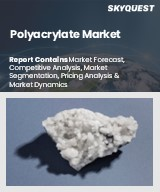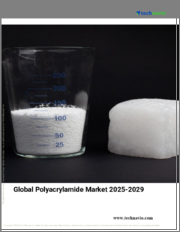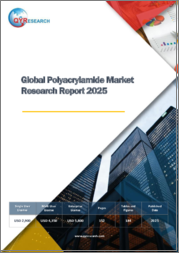
|
시장보고서
상품코드
1752357
세계의 폴리아크릴아미드(PAM) 시장 수요 및 예측 분석(2018-2034년)Global Polyacrylamide (PAM) Market Demand & Forecast Analysis, 2018-2034 |
||||||
폴리아크릴아미드(PAM)는 수용성과 응집성을 가지고 있어 널리 사용되는 범용성 높은 합성 폴리머입니다. 수처리, 폐수처리, 펄프 및 제지, 석유 회수, 선광 등 다양한 산업에서 중요한 역할을 합니다. PAM은 고액분리를 촉진하고, 여과를 개선하며, 오일 추출 효율을 향상시키는 능력으로 인해 산업 및 환경 분야 모두에서 필수적인 소재가 되었습니다.
폴리아크릴아미드 수요 분석
수처리 및 폐수처리 산업은 주요 소비자 중 하나이며 PAM 총 수요의 거의 절반을 차지합니다. 도시화, 환경 규제 강화, 지속가능한 물 관리에 대한 인식이 높아짐에 따라 효과적인 정수 솔루션에 대한 요구가 가속화되고 있으며, 폴리아크릴아미드의 응집 특성이 부유 물질과 오염 물질 제거에 중요한 역할을 하고 있습니다.
수처리 외에도 폴리아크릴아미드는 펄프 및 제지 산업에서 탈수 공정 및 종이 품질 향상에 필수적입니다. 마찬가지로, 선광 산업에서는 광석 선광 및 슬러지 처리에 PAM을 사용하여 회수율을 향상시키고 폐기물을 줄입니다. 석유 및 가스 부문도 크게 기여하고 있으며, 폴리아크릴아미드는 주입된 물의 점도를 높이고 갇힌 석유를 생산 유정으로 밀어내어 석유 회수를 강화하는 데 사용됩니다.
폴리아크릴아미드는 주로 수처리, 펄프 및 제지, 선광, 석유 회수 등 다양한 용도로 사용되어 여러 산업 분야에서 수요가 크게 증가하고 있습니다. 이 합성 폴리머는 응집제, 증점제, 안정제 역할을 하는 공정에서 필수적인 역할을 하며, 산업계의 효율성 향상과 환경 규제 준수에 기여하고 있습니다. 폴리아크릴아미드는 크게 음이온계와 양이온계로 구분되며, 음이온계 폴리아크릴아미드는 수처리 등 산업용으로 널리 사용되고 있어 시장에서 가장 큰 점유율을 차지하고 있습니다.
세계 폴리아크릴아미드 제조업체
폴리아크릴아미드 시장의 주요 제조업체는 BASF, Ashland Incorporated, Anhui Jucheng Fine Chemicals, Black Rose Industries, SNF Group, Kemira, Xitao Polymers Co. Ltd, Jiangsu Feymer Technology Company Limited, Dongying Kechuang Biochemical Industrial Company Limited, Shandong Shuiheng Chemical Company Limited, Arakawa Chemicals, Puyang Longquan Chemicals, China National Petrochemical Corporation (CNPC), Yixing Bluwat Chemicals Company 등입니다.
시장 역학
촉진요인
환경 규제 강화와 물 부족
세계 각국 정부는 폐수 배출 및 산업 폐수 배출에 대한 규제를 강화하고 있으며, 산업계는 선진적인 수처리 방법을 채택해야 합니다. 폴리아크릴아미드는 응집 및 슬러지 탈수에서 높은 효과를 발휘하기 때문에 이러한 규제 요건을 충족하는 데 필수적인 역할을 하고 있습니다. 또한, 심각한 물 부족과 농업 및 산업 분야에서 물 재사용에 대한 요구는 특히 도시화와 산업화가 급속히 진행되는 개발도상국에서 PAM 기반 솔루션의 채택을 촉진하고 있습니다.
석유 및 가스 부문 확대와 석유회수증진 기술
탄화수소에 대한 수요 증가와 추출 기술의 발전은 석유회수증진 공정에서 폴리아크릴아미드의 사용을 촉진하고 있으며, PAM의 주입액 점도를 높이는 능력은 석유 제조업체가 저류층에서 더 많은 석유를 추출하고 생산 효율을 개선하며 노후 유전의 수명을 연장 할 수 있도록합니다. 이러한 추세는 북미 및 중동과 같이 EOR 기술이 널리 사용되는 지역에서 특히 두드러집니다.
세계의 폴리아크릴아미드(PAM) 시장에 대해 조사 분석했으며, 시장 역학 및 산업 동향, 각 부문별 수요, 제조업체 프로파일 등의 정보를 전해드립니다.
목차
제1장 소개
제2장 시장 요약
- 시장의 진화
- 수요 개요
- 산업 구조
- 전략상 문제
- 최종 용도 동향
- 성장 예측
제3장 경제와 에너지 전망
- GDP와 인구통계
- 금융 정책과 재정 정책
- 원유 생산과 가격
- 천연가스
- 전기요금
제4장 최종 용도 부문 실적
- 수처리
- 펄프·제지
- 광물·광석
- 석유 및 가스
- 기타
제5장 폴리아크릴아미드(PAM) 소개와 시장 개요
- 제품 설명
- 등급과 특성
- 원재료
- 제조 공정
- 환경 문제
- 밸류체인
- 용도
제6장 시장 역학과 산업 동향
- 시장 역학
- 성장 촉진요인
- 성장 억제요인
- 기회
- 과제
제7장 세계의 폴리아크릴아미드(PAM) 수요 분석 : 용도별(수량과 금액)(2018-2034년)
- 전략상 문제와 COVID-19의 영향
- 수요 분석과 예측(2018-2034년)
- 수요
- 수요 성장률
- 성장 촉진요인 분석
- 세계의 폴리아크릴아미드(PAM) 시장 : 용도별
- 수처리
- 펄프·제지 산업
- 광업
- 기름 가공
- 기타
제8장 수요 분석과 시장 리뷰 : 지역/국가별(수량과 금액)(2018-2034년)
- 전략상 문제와 COVID-19의 영향
- 수요 분석과 예측(2018-2034년)
- 수요
- 수요 성장률
- 폴리아크릴아미드(PAM) 시장 : 용도별
- 북미
- 미국
- 캐나다
- 멕시코
- 서유럽
- 독일
- 프랑스
- 이탈리아
- 영국
- 스페인
- 기타 서유럽
- 중유럽 및 동유럽
- 러시아
- 폴란드
- 기타 중유럽 및 동유럽
- 아시아태평양
- 중국
- 일본
- 인도
- 한국
- 기타 아시아태평양
- 중남미
- 중동 및 아프리카
제9장 가격 분석
제10장 주요 전략상 문제와 사업 기회 평가
- 시장 매력 평가
- 전망과 표적 시장 조사
제11장 전략적 추천과 제안
제12장 기업 분석
- 폴리아크릴아미드(PAM) 제조업체 개요/기업 분석
- 기본 상세
- 본사, 주요 시장
- 소유
- 기업 재무
- 제조 거점
- 세계의 판매량
- 총 직원수
- 제품 포트폴리오/서비스/솔루션
- 채용된 주요 사업 전략과 Prismane Consulting 개요
- 최근 발전
- 대상 기업
- BASF
- Ashland Incorporated
- Anhui Jucheng Fine Chemicals
- SNF Group
- Kemira
- Xitao Polymers Co. Ltd
- Black Rose Industries
- ZL EOR Chemicals Limited
- Jiangsu Feymer Technology Company Limited.
- Dongying Kechuang Biochemical Industrial Company Limited
- Shandong Shuiheng Chemical Company Limited
- Arakawa Chemicals
- Puyang Longquan Chemicals
- China National Petrochemical Corporation(CNPC)
- Yixing Bluwat Chemicals Company
- 기타 제조업체
제13장 부록
ksm 25.06.30Polyacrylamide (PAM) is a versatile synthetic polymer widely used for its water-soluble and flocculating properties. It plays a crucial role in various industries including water and wastewater treatment, pulp and paper, oil recovery, and mineral processing. Its ability to enhance solid-liquid separation, improve filtration, and increase oil extraction efficiency makes PAM an indispensable material in both industrial and environmental applications.
Polyacrylamide Demand Analysis
The water and wastewater treatment industry is one of the leading consumer, accounting for nearly half of total PAM demand. Urbanization, stricter environmental regulations, and rising awareness about sustainable water management are accelerating the need for effective water purification solutions, where polyacrylamide's flocculation properties play a critical role in removing suspended solids and contaminants.
In addition to water treatment, polyacrylamide is vital in the pulp and paper industry for dewatering processes and enhancing paper quality. Similarly, mineral processing industries utilize PAM for ore beneficiation and sludge treatment, improving recovery rates and reducing waste. The oil and gas sector also contributes significantly, where polyacrylamide is used in enhanced oil recovery to increase the viscosity of injected water, pushing trapped oil toward production wells.
Polyacrylamide is witnessing robust demand growth across multiple industries, driven primarily by its versatile applications in water treatment, pulp and paper manufacturing, mineral processing, and oil recovery. This synthetic polymer is essential in processes where it acts as a flocculant, thickener, or stabilizer, helping industries improve efficiency and environmental compliance. Polyacrylamide is broadly categorized into anionic and cationic types, with anionic polyacrylamide holding the largest share in the market due to its extensive use in water treatment and other industrial applications.
Global Polyacrylamide manufacturers
Key manufacturers in the polyacrylamide market include BASF, Ashland Incorporated, Anhui Jucheng Fine Chemicals, Black Rose Industries, SNF Group, Kemira, Xitao Polymers Co. Ltd, Jiangsu Feymer Technology Company Limited, Dongying Kechuang Biochemical Industrial Company Limited, Shandong Shuiheng Chemical Company Limited, Arakawa Chemicals, Puyang Longquan Chemicals, China National Petrochemical Corporation (CNPC), and Yixing Bluwat Chemicals Company.
Market Dynamics
Drivers
- Increasing Environmental Regulations and Water Scarcity
Governments worldwide are tightening regulations on wastewater discharge and industrial effluents, compelling industries to adopt advanced water treatment methods. Polyacrylamide, being highly effective in flocculation and sludge dewatering, has become indispensable in meeting these regulatory requirements. Additionally, rising water scarcity and the need for water reuse in agriculture and industry are driving the adoption of PAM-based solutions, especially in developing countries undergoing rapid urbanization and industrialization.
- Expansion of Oil & Gas Sector and Enhanced Oil Recovery Technologies:
The growing demand for hydrocarbons and advancements in extraction techniques are encouraging the use of polyacrylamide in enhanced oil recovery processes. PAM's ability to increase the viscosity of injection fluids allows oil producers to extract more oil from reservoirs, improving production efficiency and extending the life of mature fields. This trend is particularly pronounced in regions like North America and the Middle East, where EOR technologies are widely applied.
Table of Contents
1. Introduction
- Scope
- Market Coverage
- Application
- Regions
- Countries
- Years Considered
- Historical - 2018 - 2023
- Base - 2024
- Forecast Period - 2025 - 2034
- Research Methodology
- Approach
- Research Methodology
- Prismane Consulting Market Models
- Assumptions & Limitations
- Abbreviations & Definitions
- Conversion Factors
- Data Sources
2. Market Synopsis
- Market Evolution
- Demand Overview
- Industry Structure
- Strategic Issues
- End-use Trends
- Growth Forecast
3. Economic & Energy Outlook
- GDP and Demographics
- Monetary & Fiscal Policies
- Crude Oil Production and prices
- Natural Gas
- Electricity Prices
4. End-use Sector Performance
- Water Treatment
- Pulp & Paper
- Minerals & Ores
- Oil & Gas
- Others
5. Introduction to Polyacrylamide (PAM) and Market Overview
- Product Description
- Grades & Properties
- Raw Material
- Manufacturing Process
- Environmental Issues
- Value Chain
- Applications
6. Market Dynamics and Industry Trends
- Market Dynamics
- Drivers
- Restraints
- Opportunities
- Challenges
7. Global Polyacrylamide (PAM) Demand Analysis, By Application (Volume, Value) (2018 - 2034)
- Strategic Issues and COVID-19 Impact
- Demand Analysis and Forecast (2018 - 2034)
- Demand
- Demand Growth Rate (%)
- Driving Force Analysis
- Global Polyacrylamide (PAM) Market, By Application
- Water Treatment
- Pulp & Paper Industry
- Mineral Industry
- Oil Processing
- Others
8. Demand Analysis and Market Review, By Region, By Country (Volume, Value), (2018-2034)
- Strategic Issues and COVID-19 Impact
- Demand Analysis and Forecast (2018 - 2034)
- Demand
- Demand Growth Rate (%)
- Polyacrylamide (PAM) Market, By Application
Note: Demand Analysis has been provided for all major Regions / Countries as mentioned below. The demand (consumption) split by application has been provided for each of the countries / regions in Volume (Kilo tons) and Value (USD Million).
- North America
- USA
- Canada
- Mexico
- Western Europe
- Germany
- France
- Italy
- United Kingdom
- Spain
- Rest of Western Europe
- Central & Eastern Europe
- Russia
- Poland
- Rest of Central & Eastern Europe
- Asia-Pacific
- China
- Japan
- India
- South Korea
- Rest of Asia-Pacific
- Central & South America
- Middle East & Africa
Note: CAGR will be calculated for all applications to arrive at the regional / global demand growth for the forecast period (2025 - 2034)
9. Pricing Analysis
10. Key Strategic Issues and Business Opportunity Assessment
- Market Attractiveness Assessment
- Prospective & Target Market Study
11. Strategic Recommendation & Suggestions
12. Company Analysis
- Polyacrylamide (PAM) Manufacturers Profiles/ Company Analysis
- Basic Details
- Headquarter, Key Markets
- Ownership
- Company Financial
- Manufacturing Bases
- Global Turnover
- Total Employee
- Product Portfolio / Services / Solutions
- Key Business Strategies adopted and Prismane Consulting Overview
- Recent Developments
- Companies Covered -
- BASF
- Ashland Incorporated
- Anhui Jucheng Fine Chemicals
- SNF Group
- Kemira
- Xitao Polymers Co. Ltd
- Black Rose Industries
- ZL EOR Chemicals Limited
- Jiangsu Feymer Technology Company Limited.
- Dongying Kechuang Biochemical Industrial Company Limited
- Shandong Shuiheng Chemical Company Limited
- Arakawa Chemicals
- Puyang Longquan Chemicals
- China National Petrochemical Corporation (CNPC)
- Yixing Bluwat Chemicals Company
- Other Manufacturers
Note: This section includes company information, company financials, manufacturing bases and operating regions. Company financials have been mentioned only for those companies where financials were available in SEC Filings, annual reports, or company websites. All the reported financials in this report are in U.S. Dollars. Financials reported in other currencies have been converted using average currency conversion rates. Company profiles may include manufacturers, suppliers, and distributors.
13. Appendices
- Demand - Regions
- Demand - Countries



















